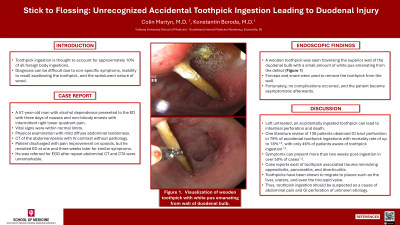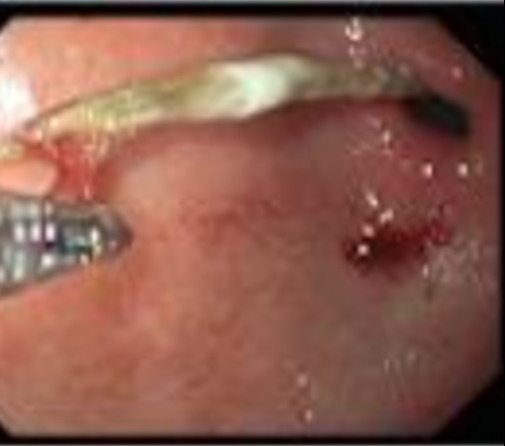Sunday Poster Session
Category: Small Intestine
P1316 - Stick to Flossing: Unrecognized Accidental Toothpick Ingestion Leading to Duodenal Injury
Sunday, October 22, 2023
3:30 PM - 7:00 PM PT
Location: Exhibit Hall

Has Audio

Colin P. Martyn, MD
Indiana University
Newburgh, IN
Presenting Author(s)
Colin P. Martyn, MD1, Konstantin Boroda, MD2
1Indiana University, Newburgh, IN; 2Digestive Care Center, Newburgh, IN
Introduction: Toothpick ingestion is thought to account for approximately 10% of all foreign body ingestions and is associated with significant morbidity and mortality if left untreated. Diagnosis can be difficult due to non-specific symptoms, inability to recall swallowing the toothpick, and the radiolucent nature of wood. We present a case of a 57-year-old man with alcohol dependence who was found on endoscopy to have a toothpick embedded in his duodenum after multiple negative imaging studies in the emergency department.
Case Description/Methods: A 57-year-old man with alcohol dependence presented to the ED with 3 days of nausea and non-bloody emesis. He reported intermittent sharp pain in his right lower quadrant but denied fever, hematochezia, diarrhea, and chest pain. Vital signs were within normal limits and physical examination was notable for mild diffuse abdominal tenderness. Labs including CBC, CMP, lipase, and blood alcohol levels were unremarkable. CT of the abdomen/pelvis with IV contrast did not demonstrate gastrointestinal pathology. He was discharged after overnight pain improvement on opioids but returned 5 and 21 days later to the ED for pain recurrence. He was referred for EGD after repeat abdominal CT and subsequent CTA failed to elucidate the cause of his pain. On EGD, a toothpick was seen traversing the superior wall of the duodenal bulb and was removed using forceps and a snare. A small amount of white pus emanated from the defect. The patient has remained asymptomatic since the toothpick removal.
Discussion: Left untreated, an accidentally ingested toothpick can lead to intestinal perforation and death. Fortunately, our patient avoided this complication. One literature review of 136 patients with accidental toothpick ingestion documented gastrointestinal tract perforation in 79% of patients with a mortality rate of up to 18%. Additionally, only 46% of patients were aware of toothpick ingestion with symptoms presenting more than 2 weeks after ingestion in over 50% of cases. Due to the radiolucency of wooden toothpicks, plain radiography and CT are poorly sensitive and specific. Case reports exist of toothpick associated foreign body trauma mimicking pancreatitis, appendicitis, and diverticulitis. Toothpicks can also migrate to various locations such as the liver, ureters, and even the tricuspid valve. Thus, toothpick ingestion should be suspected as a cause of abdominal pain and gastrointestinal perforation of unknown etiology.

Disclosures:
Colin P. Martyn, MD1, Konstantin Boroda, MD2. P1316 - Stick to Flossing: Unrecognized Accidental Toothpick Ingestion Leading to Duodenal Injury, ACG 2023 Annual Scientific Meeting Abstracts. Vancouver, BC, Canada: American College of Gastroenterology.
1Indiana University, Newburgh, IN; 2Digestive Care Center, Newburgh, IN
Introduction: Toothpick ingestion is thought to account for approximately 10% of all foreign body ingestions and is associated with significant morbidity and mortality if left untreated. Diagnosis can be difficult due to non-specific symptoms, inability to recall swallowing the toothpick, and the radiolucent nature of wood. We present a case of a 57-year-old man with alcohol dependence who was found on endoscopy to have a toothpick embedded in his duodenum after multiple negative imaging studies in the emergency department.
Case Description/Methods: A 57-year-old man with alcohol dependence presented to the ED with 3 days of nausea and non-bloody emesis. He reported intermittent sharp pain in his right lower quadrant but denied fever, hematochezia, diarrhea, and chest pain. Vital signs were within normal limits and physical examination was notable for mild diffuse abdominal tenderness. Labs including CBC, CMP, lipase, and blood alcohol levels were unremarkable. CT of the abdomen/pelvis with IV contrast did not demonstrate gastrointestinal pathology. He was discharged after overnight pain improvement on opioids but returned 5 and 21 days later to the ED for pain recurrence. He was referred for EGD after repeat abdominal CT and subsequent CTA failed to elucidate the cause of his pain. On EGD, a toothpick was seen traversing the superior wall of the duodenal bulb and was removed using forceps and a snare. A small amount of white pus emanated from the defect. The patient has remained asymptomatic since the toothpick removal.
Discussion: Left untreated, an accidentally ingested toothpick can lead to intestinal perforation and death. Fortunately, our patient avoided this complication. One literature review of 136 patients with accidental toothpick ingestion documented gastrointestinal tract perforation in 79% of patients with a mortality rate of up to 18%. Additionally, only 46% of patients were aware of toothpick ingestion with symptoms presenting more than 2 weeks after ingestion in over 50% of cases. Due to the radiolucency of wooden toothpicks, plain radiography and CT are poorly sensitive and specific. Case reports exist of toothpick associated foreign body trauma mimicking pancreatitis, appendicitis, and diverticulitis. Toothpicks can also migrate to various locations such as the liver, ureters, and even the tricuspid valve. Thus, toothpick ingestion should be suspected as a cause of abdominal pain and gastrointestinal perforation of unknown etiology.

Figure: Endoscopic view of wooden toothpick emanating from the superior wall of the duodenal bulb.
Disclosures:
Colin Martyn indicated no relevant financial relationships.
Konstantin Boroda indicated no relevant financial relationships.
Colin P. Martyn, MD1, Konstantin Boroda, MD2. P1316 - Stick to Flossing: Unrecognized Accidental Toothpick Ingestion Leading to Duodenal Injury, ACG 2023 Annual Scientific Meeting Abstracts. Vancouver, BC, Canada: American College of Gastroenterology.
